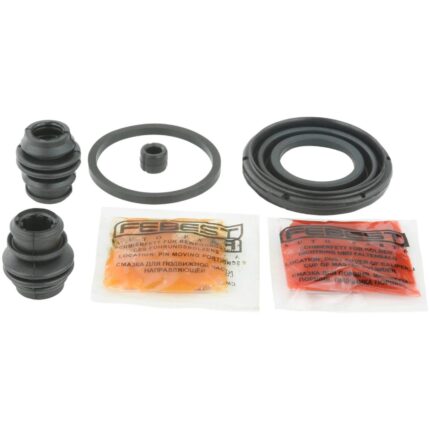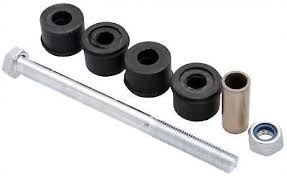-25%
Get Mitsubishi Colt Mirage Front Stabilizer Link Assy RH/LH
A stabilizer link assembly, commonly known as a sway bar link or anti-roll bar link, is a critical component of a vehicle’s suspension system designed to enhance stability, improve handling, and reduce body roll during cornering. It connects the stabilizer bar (sway bar) to the suspension components, typically the control arms or struts, ensuring proper alignment and coordinated movement between the left and right wheels. Here’s an in-depth exploration of stabilizer link assemblies, covering their functions, components, types, importance, signs of issues, replacement considerations, and maintenance tips.
Functions and Components of Stabilizer Link Assy
- Connect Stabilizer Bar to Suspension: The primary function of a stabilizer link assembly is to connect the stabilizer bar to the suspension system of the vehicle. This linkage allows the stabilizer bar to transfer forces from one side of the suspension to the other, helping to maintain stability during turns and uneven road conditions.
- Reduce Body Roll: During cornering or sudden maneuvers, the stabilizer link assembly transfers forces from the outer wheel to the inner wheel, minimizing body roll. This improves vehicle stability and enhances overall handling performance.
- Maintain Wheel Alignment: By connecting the stabilizer bar to the suspension components, the stabilizer link assembly helps maintain proper wheel alignment. It ensures that both wheels on the same axle move in tandem, preventing excessive tire wear and optimizing tire grip.
- Absorb Road Vibrations: Stabilizer link assemblies are equipped with bushings and ball joints that absorb road vibrations and shocks. This improves ride comfort by reducing the transmission of bumps and vibrations from the road surface to the vehicle’s chassis.
Types of Stabilizer Link Assemblies
- Fixed/Stiff Links: Fixed or stiff stabilizer links are typically found in older vehicles or heavy-duty applications. They provide robust support and durability but may transmit more road vibrations to the chassis.
- Adjustable Links: Adjustable stabilizer links allow for fine-tuning of the suspension system. They feature threaded bodies or turnbuckles that enable length adjustment, allowing vehicle owners or mechanics to customize the handling characteristics and alignment.
- Performance Links: Performance stabilizer links are designed for enthusiasts or high-performance vehicles. They often feature upgraded materials, such as reinforced steel or aluminum, and precision components for enhanced durability and handling response.
Importance of Stabilizer Link Assy
Stabilizer link assemblies play a crucial role in vehicle dynamics and safety:
- Enhanced Stability: By reducing body roll and maintaining consistent handling characteristics, stabilizer link assemblies contribute to vehicle stability, especially during aggressive maneuvers or emergency situations.
- Improved Handling: Properly functioning stabilizer link assemblies ensure predictable and responsive handling, enhancing driver control and confidence on the road.
- Reduced Tire Wear: By maintaining proper wheel alignment, stabilizer links help reduce uneven tire wear, extending the lifespan of tires and optimizing traction.
Signs of Issues with Stabilizer Link Assy
- Clunking or Rattling Noises: Worn or damaged stabilizer link assemblies often produce clunking or rattling noises, especially when driving over bumps or rough roads. This indicates loose or worn-out ball joints, bushings, or mounting hardware.
- Steering Instability: Excessive play or instability in the steering wheel, especially during cornering, may indicate issues with the stabilizer link assemblies affecting alignment and responsiveness.
- Uneven Tire Wear: Misaligned or worn stabilizer links can cause uneven tire wear patterns, typically on the inner or outer edges of the tires.
- Visible Damage or Movement: Inspect the stabilizer link assemblies for visible signs of damage, such as cracks in the rubber bushings, corrosion on metal components, or excessive movement in the linkage during vehicle operation.
Replacement Considerations
- Complete Assembly vs. Components: Depending on the extent of wear or damage, you may opt to replace the entire stabilizer link assembly or individual components such as bushings, ball joints, or mounting hardware.
- Quality Parts: Use high-quality OEM or aftermarket stabilizer link assemblies and components from reputable manufacturers to ensure proper fitment, durability, and performance.
- Professional Installation: For complex repairs or if you’re unsure about the process, seek assistance from a qualified mechanic or automotive technician experienced in suspension system repairs.
- Alignment Check: After replacing stabilizer link assemblies, perform a wheel alignment to ensure proper suspension geometry and optimize handling and tire wear.
Maintenance Tips
- Regular Inspection: Include stabilizer link assemblies in routine suspension inspections, checking for signs of wear, noise, or movement. Address any issues promptly to prevent further damage to suspension components.
- Lubrication: Lubricate the ball joints, bushings, and pivot points of stabilizer link assemblies as recommended by the vehicle manufacturer to ensure smooth operation and extend component life.
- Avoid Overloading: Avoid overloading your vehicle beyond its recommended capacity, as excessive weight can accelerate wear on suspension components, including stabilizer link assemblies.
Follow us on Facebook for more parts.



